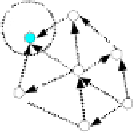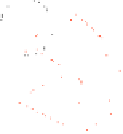Information Technology Reference
In-Depth Information
Eve
nt
Eve
nt
E
vent
S
ource
Source
Interest
S
ource
Reinforced Path
Grad
i
en
t
Sink
Node
Sink
Node
Sink Node
(a) Interest propagation
(b) Initial gradients set up
(c) Data delivery along
the reinforced path
Fig. 1.
Directed Diffusion [9]
3.3 Wireless Sensor Tissue
Readers familiar with the field of AIS should find the properties of the sensor network
using Directed Diffusion very familiar, because they mirror many of the properties of
AIS algorithms. In this work we regard sensor networks as a suitable metaphor for the
tissue of an organism - with diffusing packets acting as signals between cells. Using
the work of Bentley [3] and Tycross [15] to aid this analogy:
•
Tissue cells have limited processing, storage, and communication capacity; while
a cell has its own capability of processing and storage, it takes a limited amount of
input proteins such as cytokines or binds to a restricted number of neighbour cells.
As described in
(P1)
sensor networks share these features.
•
Biological tissue comprises a large number of cells. A tissue cell is the basic
structural and functional unit, capable of functioning independently. A sensor
network is similarly structured, see (
P2
).
•
Each cell is prone to failure: cells in biological tissue are continuously exposed to
pathogenic attacks, just as individual nodes of a sensor network are at risk, see
(P3)
. Later sections explain how an immune algorithm can integrate with a sensor
network to help detect and overcome such attacks.
•
The cells in living tissue move and reorganise themselves, just as nodes of a
sensor network may move or be deployed in different places and have variable
topologies, see
(P4)
and
(P5)
.
•
Communication between biological cells is through the diffusion of signalling
proteins and the matching of antigenic patterns; communication between sensor
network nodes (using the Directed Diffusion protocol) is through diffusion and the
matching of packets, see
(P6)
.
•
Tissue cells are self-organising, growing without predetermined global control; the
spatial and temporal information is passed by signals while receptors help the
entire structure of the tissue develop. Likewise a sensor network automatically and
dynamically forms its connectivity, see
(P7)
.
•
Biological tissue cells are distributed, they work in parallel, signalling to each
other to perform the desired functions. A sensor network is a truly distributed
system with nodes that are processing in parallel and communicating with each
other, see
(P8)
.







































































































































































































































